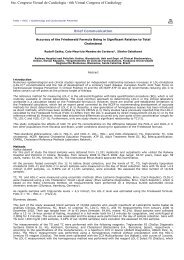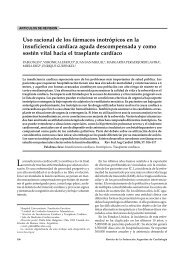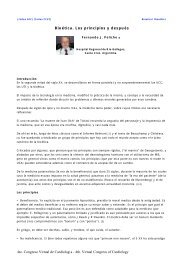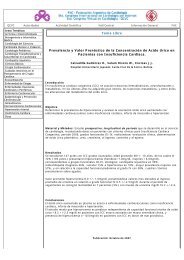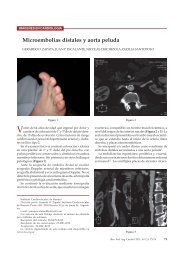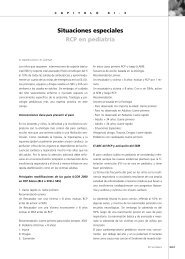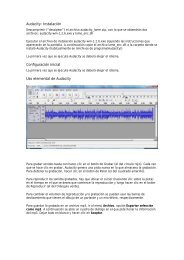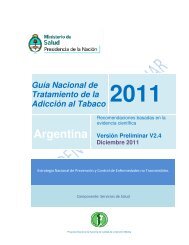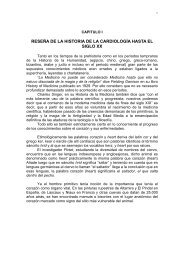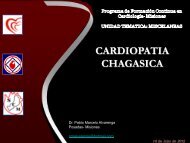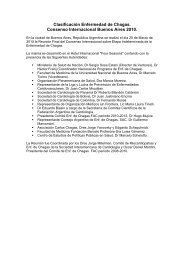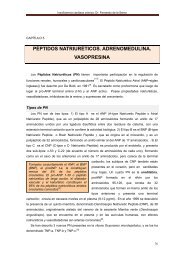Jiri Vitek - Stent supported Carotid Artery... 5th. International ... - FaC
Jiri Vitek - Stent supported Carotid Artery... 5th. International ... - FaC
Jiri Vitek - Stent supported Carotid Artery... 5th. International ... - FaC
You also want an ePaper? Increase the reach of your titles
YUMPU automatically turns print PDFs into web optimized ePapers that Google loves.
<strong>Jiri</strong> <strong>Vitek</strong> - <strong>Stent</strong> <strong>supported</strong> <strong>Carotid</strong> <strong>Artery</strong>...<br />
QCVC Committees Scientific Activities Central Hall General Information FAC<br />
Thematic Units<br />
Arrhythmias and<br />
Electrophysiology<br />
Basic Research<br />
Bioengineering and Medical<br />
Informatics<br />
Cardiac Surgical Intensive Care<br />
Cardiomyopathies<br />
Cardiovascular Nursing<br />
Cardiovascular Pharmacology<br />
Cardiovascular Surgery<br />
Chagas Disease<br />
Echocardiography<br />
Epidemiology and<br />
Cardiovascular Prevention<br />
Heart Failure<br />
Hemodynamics - Cardiovascular<br />
Interventions<br />
High Blood Pressure<br />
Ischemic Heart Disease<br />
Nuclear Cardiology<br />
Pediatric Cardiology<br />
Peripheral and Cerebral<br />
Vascular Diseases<br />
Sports Cardiology<br />
Technicians in Cardiology<br />
Transdisciplinary Cardiology and<br />
Mental Health in Cardiology<br />
<strong>Stent</strong> <strong>supported</strong> <strong>Carotid</strong> <strong>Artery</strong><br />
Angioplasty as Prevention of Stroke<br />
<strong>Jiri</strong> <strong>Vitek</strong>*<br />
Sriram Iyer, Gary Roubin<br />
Lenox Hill Heart and Vascular Institute of New York,<br />
New York, NY, USA<br />
<strong>Carotid</strong> artery stenting (CAS) is being investigated as an endovascular alternative to carotid<br />
endarterectomy (CEA) for the treatment of obstructive carotid stenoses. The goal of both procedures<br />
is to prevent stroke caused by extracranial carotid disease. CAS offers patients a less invasive and<br />
less traumatic means of achieving this goal. The efficacy of CAS in preventing stroke depends on the<br />
ability of the operator to achieve complication-free results by careful consideration of the patients<br />
selected and meticulous performance of the intervention. The recent application of embolic protection<br />
devices, designed to capture embolic matter released during the stenting procedure before it reaches<br />
the brain, has added an important dimension to the performance of safe carotid stenting. This report<br />
provides a step-by-step approach to the clinical and technical aspects of the carotid stenting<br />
procedure in an effort to ensure safer outcomes.<br />
<strong>Carotid</strong> angioplasty and stenting (CAS) has evolved rapidly over the last decade. Since Dotter, Judkins<br />
[1,2], and Grüntzig’s [3] pioneering work, few procedures have met with such vigorous scrutiny and<br />
criticism as carotid stenting. Given the potential for procedural neurological complications and the<br />
existence of a well-validated surgical approach, caution has always been warranted. In the case of<br />
carotid stenting, opposition in the U.S. surgical community [4] has delayed the approval of advanced<br />
devices and techniques, slowed progress in clinical trials, and has created limited access for patients<br />
who might benefit from the procedure. However, despite resistance, carotid stenting has become<br />
widely accepted as a viable alternative to carotid endarterectomy (CEA).<br />
Historical Perspective<br />
CEA was introduced in the early 1950s for the prevention of embologenic etiology of stroke from<br />
atherosclerotically narrowed carotid bifurcation and internal carotid artery (ICA). By the early 1990s,<br />
at least three prospective randomized trials had demonstrated that CEA indeed reduced the risk of<br />
stroke in patients with carotid stenoses [5–7]. The results of these trials confirmed a large body of<br />
prospective observational data that suggested a benefit of surgery over medical therapy, depending<br />
on symptom status and the severity of stenosis. Furthermore, the data confirmed the view that if the<br />
periprocedural stroke and mortality risks of CEA were low, patients benefited. However, prospective<br />
trials documented a significant perioperative risk that had not been highlighted by the surgeons. In<br />
NASCET (North American Symptomatic Endarterectomy Trial), in addition to a 5.8% rate of<br />
neurological complications, the 30-day adverse events that were associated with the open surgical<br />
procedure were:<br />
• Perioperative cranial nerve damage (5.6%).<br />
• Medical complications (8.1%).<br />
• Myocardial infarction (MI, 1.2%).<br />
• Congestive heart failure (CHF, 1.2%).<br />
(Additionally all patients required general anesthesia.)<br />
In the 1980s, interventional radiologists started to cautiously approach stenotic afflictions in the<br />
carotid arteries. In 1977 and 1980, Mathias et al. reported successful results with the use of<br />
percutaneous angioplasty for carotid stenosis [8, 9]. In the early 1980s, Hasso et al. and Belan et al.<br />
reported successful ICA angioplasty in fibromuscular dysplasia [10,11], and 1983 saw Bockenheimer et<br />
al., Wiggli and Gratzl, Tsai et al., and Theron et al. publish their results on carotid angioplasty in<br />
atherosclerotic disease [12–15]. In 1984, Rabkin et al. reported on the experimental use of<br />
<strong>5th</strong>. <strong>International</strong> Congress of Cardiology on the Internet
<strong>Jiri</strong> <strong>Vitek</strong> - <strong>Stent</strong> <strong>supported</strong> <strong>Carotid</strong> <strong>Artery</strong>...<br />
intravascular Nitinol stents [16], and Theron et al. [17] began their pivotal work with distal balloon<br />
protection during carotid bifurcation angioplasty, later supplemented by stents. From a historical<br />
perspective, the first insertion of a (glass) tubular structure into the blood vessel of an animal was<br />
reported by Carrel in 1912 [18]. Use of silastic tubes was attempted by Dotter in 1969, but these were<br />
shown to thrombose and migrate [19]. In 1983, Dotter et al. reported the use of uncoated stainless<br />
steel or nickel titanium alloy wire coils with more success [20]. In the same year, Cragg et al. [21], and<br />
1 year later, Maass et al. [22], reported on using nitinol spiral endoprostheses in animal experiments.<br />
Less known is the fact that, in 1973, Kononov [23] implanted a balloon expandable stent graft into a<br />
dog’s aorta. After multiple successful experiments, on May <strong>5th</strong>, 1979, he obtained a patent on a<br />
“device for implanting a prosthesis in a tubular organ”. In 1990, Rabkin et al. [24] reported that they<br />
had been successfully implanting Nitinol self-expandable stents inhuman iliac arteries since 1984. The<br />
successful placement of an endovascular graft transluminally to treat a patient with iliac artery<br />
occlusive disease was achieved by Volodos et al. in 1985 [25].<br />
As was the case in other arterial sites, the evolution and availability of arterial stents transformed the<br />
less predictable carotid balloon angioplasty, and by the early 1990s prospective observational studies<br />
of carotid stenting had been initiated [26–29]. From the outset, carotid stenting performed by<br />
experienced operators produced acceptable outcomes, with a 1% rate of major complications. Non –<br />
disabling neurological events (approximately 6%) were found in<br />
patients with advanced age and more complex, severe stenoses [30]. Given the nature of the carotid<br />
lesion, the incidence of embolic neurological events was not entirely unexpected, and led to the<br />
development of embolic protection techniques and devices. In 1983, <strong>Vitek</strong> et al. reported angioplasty<br />
of the innominate artery with distal occlusion balloon protection of the common carotid artery (CCA)<br />
[31]. Henry et al. [32] perfected Theron’s technique [17] with a low profile occlusion balloon system for<br />
embolic protection. Parodi et al. [33] focused on proximal occlusion devices that facilitated embolic<br />
protection by temporarily reversing flow in the ICA. Recently, several distal embolic filter devices have<br />
been developed. As different embolic protection systems became available, a number of single-center<br />
studies and multicenter registries confirmed the ability of experienced operators to achieve excellent<br />
results with CAS, with a remarkably low risk of embolic complications [34–37]. Consequently, the<br />
simplicity of this less invasive approach together with its low morbidity rate has accelerated the<br />
acceptance of CAS in medical community.<br />
Indications<br />
In general, the indications for CAS are similar to those for carotid surgery with respect to symptomatic<br />
status and severity of carotid stenosis. There are notable exceptions to this therapeutic principle.<br />
Subsets of patients are emerging as better candidates for CAS, while others appear to be better<br />
candidates for CEA. Patients who have co-morbid medical conditions that would increase the risk of an<br />
open surgical procedure or the use of general anesthesia are primary candidates for stenting. Based<br />
on results from the recent SAPPHIRE (<strong>Stent</strong>ing and Angioplasty with Protection in Patients at High<br />
Risk for Endarterectomy) trial [38], these conditions include:<br />
• Age >80 years.<br />
• CHF and/or severe left ventricular dysfunction.<br />
• Opened heart surgery needed within 6 weeks.<br />
• Recent MI.<br />
• Unstable angina.<br />
• Severe pulmonary disease.<br />
In addition, any condition that would increase the risk of surgery represents a probable indication for<br />
CAS, including:<br />
• Isolated brain hemisphere by arterial supply.<br />
• Contralateral occlusion of the ICA.<br />
• Prior ipsilateral endarterectomy.<br />
• Prior neck dissection or radiation.<br />
• High lesions behind the mandible.<br />
• Low lesions that require thoracic exposure.<br />
The advantage of an endovascular approach is that the angiographic status (anatomy, collaterals,<br />
status of circle of Willis, intracranial lesions, and flow characteristics) is usually well defined prior to<br />
the stenting procedure. Although not emphasized in the carotid surgery trials, the incidence of cranial<br />
nerve damage, wound hematoma, and infection are also significant and must be considered before<br />
referring the patient for neck surgery.<br />
Contraindications<br />
There is a number of notable relative contraindications to carotid stenting. Patients who are intolerant<br />
<strong>5th</strong>. <strong>International</strong> Congress of Cardiology on the Internet
<strong>Jiri</strong> <strong>Vitek</strong> - <strong>Stent</strong> <strong>supported</strong> <strong>Carotid</strong> <strong>Artery</strong>...<br />
to a combination of antiplatelet agents are more safely managed with CEA. Similarly, CEA may be a<br />
better option if the patient has a compelling reason to undergo a major surgical procedure within 3–4<br />
weeks that will require the cessation of antiplatelet therapy. Another relative contraindication to CAS<br />
is the presence of chronic renal failure, although experienced operators can complete the procedure<br />
using 50–75 cc of contrast or use Gadolinium contrast. The important relative anatomical<br />
contraindications that increase the risk of performing CAS are:<br />
• Severe diffuse atherosclerotic disease, calcifications, elongation, and tortuosity of<br />
the brachiocephalic vessels and aortic arch, which make access to the carotid<br />
bifurcation difficult, riskier, and occasionally impossible (Figure 1A and 1B).<br />
• Severe tortuosity in the region of the carotid bifurcation (Figure 1C).<br />
• Severe calcification completely surrounding the stenotic segment (Figure 1D).<br />
Figure 1: Lesions unsuitable for CAS.<br />
a. Diffuse atherosclerotic disease in the common carotid artery (CCA).<br />
b. Anatomically unsuitable approach due to the tortuosity of the CCA.<br />
c. Severe tortuosity of the internal carotid artery (ICA) preventing safe placement of the<br />
protection device and stent.<br />
d. Heavy circumferential, concentric calcifications and distal tortuosity.<br />
Placement of embolic protection systems, guide wires, and stents is much more complicated in such<br />
anatomical conditions, and the degree of tortuosity can be substantially increased after placement of a<br />
carotid access sheath (Figure 2). In addition, the presence of a mobile thrombus should be ruled out<br />
before CAS.<br />
<strong>5th</strong>. <strong>International</strong> Congress of Cardiology on the Internet
<strong>Jiri</strong> <strong>Vitek</strong> - <strong>Stent</strong> <strong>supported</strong> <strong>Carotid</strong> <strong>Artery</strong>...<br />
Figure 2: Kink created (arrow) in the distal segment of the ICA by placement<br />
of the sheath in the CCA (bifurcation displaced cephalad).<br />
The conditions that are not define as a contraindications for CAS include intracranial stable<br />
aneurysms, AVMs, and fistulas. Critical control of hypertension and modulation of anticoagulation is<br />
mandatory in these conditions.<br />
Management of the Procedure<br />
The carotid stenting protocol in the Lenox Hill Heart and Vascular Institute (LHHVI, New York, NY,<br />
USA) has been described in detail previously [39]. In the pre-procedural management of patients,<br />
adequate dual antiplatelet therapy is vital. On the day of the procedure, oral antihypertensive therapy<br />
is withheld and the patient must be well hydrated. Mild sedation may be offered to anxious patients<br />
prior to the procedure but for the vast majority gentle reassurance combined with local anesthesia is<br />
all that is necessary. This approach also facilitates continuous, accurate pre-, intra-, and postprocedural<br />
neurological monitoring. Intra-procedural monitoring can be accomplished by engaging in<br />
verbal contact with the patient and by having them squeeze a toy placed in the contralateral hand<br />
after every step of the intervention. Pulse oximetry, intra-arterial pressure and heart rate monitoring,<br />
and careful control of hemodynamics are essential elements of the procedure. Atropine (0.6–1 mg)<br />
should be administered after placement of the sheath in the CCA to suppress the baro-receptors. If<br />
the blood pressure remains elevated after the stenosis has been relieved, it should be rapidly lowered<br />
using intravenous nitroglycerine, nitroprusside, or another appropriate rapidly acting agent. When an<br />
occlusion balloon embolic protection system is used, the blood pressure should be lowered before the<br />
protection balloon is deflated. Occasionally, substantial hypotension is noted after post-dilation of the<br />
stent, particularly in elderly patients. However, the hypotension is invariably benign and does not<br />
require aggressive treatment. Patients who have separate critical disease in the intracranial,<br />
extracranial, or coronary vessels should be treated with intravenous phenylephrine, aggressive<br />
hydration, and, occasionally, dopamine infusions. Anticoagulation during stenting is critical, but only<br />
modest anticoagulation levels (activated clotting time [ACT] 200–250 s) are necessary and should be<br />
monitored during the intervention. Depending on body weight, either heparin (4000 IU) or bivalirudin<br />
is used. Glycoprotein IIb/IIIa receptor antagonists are not used in our center.<br />
The current CAS technique requires the use of 6-F femoral access sheaths; femoral closure devices<br />
are used frequently before the patient leaves the interventional suite. Accordingly, patients can sit up<br />
and begin to ambulate almost immediately. This allows full neurological assessment, and the<br />
subsequent natural release of catecholamine counteracts much of the bradycardia and hypotension<br />
associated with stent placement. Intensive post-procedural care is unnecessary. Instead, patients<br />
should be managed in a monitored bed with nursing staff who are familiar with post-CAS patient care.<br />
If the sheath is not removed in the interventional suite with femoral closure systems, it should be<br />
removed as soon as possible by experienced personnel once the ACT has fallen to
<strong>Jiri</strong> <strong>Vitek</strong> - <strong>Stent</strong> <strong>supported</strong> <strong>Carotid</strong> <strong>Artery</strong>...<br />
retroperitoneal bleeding, are not overlooked. Patients who have an uncomplicated procedure and<br />
percutaneous femoral closure device can be discharged on the same day.<br />
Patients are discharged on a combination of clopidogrel (75 mg) and aspirin (325 mg) for 1 month,<br />
after which aspirin is continued indefinitely. The exception to this regimen are patients treated for<br />
post-CEA or post-radiation stenosis in whom the Plavix/aspirin treatment is extended for<br />
approximately 1 year. Baseline ultrasound duplex studies within 1 month serve as a reference for<br />
future follow-up evaluations in these patients. Frequently, despite good angiographic results, blood<br />
velocities within the stent become elevated. However, the evidence to date suggests that this finding<br />
is not predictive of excessive progression of neointimal proliferation or restenosis [40]. Magnetic<br />
resonance angiography is not used for follow-up purposes due to signal dropout associated with the<br />
metallic stent. Computerized tomographic angiography, however, has shown some promise and may<br />
prove to be the follow-up modality of choice. Significant angiographic restenosis >80% is an<br />
uncommon finding. Cases of restenosis are seen more commonly in patients with stenosis associated<br />
with radiation-induced injury and in those treated for post- CEA restenosis. Restenosis occurring after<br />
stent placement can be managed by repeat balloon dilation and, occasionally, by additional stenting.<br />
<strong>Stent</strong>ing Technique<br />
The stenting technique has been covered in detail previously (Figure 3 - 5) [39]. Transcranial Doppler<br />
studies have shown the importance of performing the intervention with minimum manipulation of the<br />
lesion. If significant difficulties are encountered during sheath placement or passing the guide wire or<br />
embolic protection device, the decision to proceed must be reassessed. Few embolic particles are<br />
generated during careful sheath placement or crossing the lesion with an embolic protection system; a<br />
modest number of particles is released with pre-dilation, followed by stent deployment; and the<br />
largest number of particles is released during post-dilation of thestent.<br />
<strong>5th</strong>. <strong>International</strong> Congress of Cardiology on the Internet<br />
Figure 3A: a. Collapsed ICA with 98% ostial stenosis. (Recanalized occlusion?)<br />
b. Pre-predilatation with 2 x 40 mm balloon over 0.014” Choice PT.<br />
c. Guard wire occusion balloon advanced into the ICA and deployed.
<strong>Jiri</strong> <strong>Vitek</strong> - <strong>Stent</strong> <strong>supported</strong> <strong>Carotid</strong> <strong>Artery</strong>...<br />
<strong>5th</strong>. <strong>International</strong> Congress of Cardiology on the Internet<br />
Figure 3B: a. Pre-dilatation with 4 x 30 balloon.<br />
b. <strong>Stent</strong> post-dilatation with 5x20 balloon.<br />
c.Status post. CAS.<br />
Figure 4 A: Placement of the (embolic protection device) filter<br />
with the help of the “buddy wire”.<br />
a. Symptomatic stenosis with angulation in the left ICA.<br />
b. Stiffness of the Accunet filter prevents advancement.<br />
c. 0.014” Stabilizer Plus advanced into the ICA.
<strong>Jiri</strong> <strong>Vitek</strong> - <strong>Stent</strong> <strong>supported</strong> <strong>Carotid</strong> <strong>Artery</strong>...<br />
Figure 4 B: a. Accunet filter advanced into the ICA.<br />
b. Accunet filter opened. Stabilizer Plus removed.<br />
c. Status post CAS.<br />
Figure 5: Placement of the (protection device) occlusion balloon with the help<br />
of the “buddy catheter”.<br />
- 90 degree take-off of the left ICA with 80% angulated stenosis.<br />
- “Buddy wire” (125 cm JR4 catheter) placed in the ostium of the ICA through the 6F<br />
sheath. Guard wire with occlusion balloon advanced through the JR4 catheter into the<br />
ICA.<br />
- Guard wire balloon inflated.<br />
- Status post CAS.<br />
These observations support the view that if an embolic protection system cannot be passed through<br />
the lesion in a safe expeditious manner before pre-dilation, it can be deployed after mini 2-mm<br />
balloon pre-dilation (Figure 3) or just before stent post-dilation, which is less efficacious, but still<br />
useful.<br />
If available, flow reversal embolic protection systems can be used (Figure 6) in patients who have an<br />
intact Circle of Willis and thus a good collateral supply in addition to suitable iliac and proximal carotid<br />
anatomy to facilitate placement of this higher profile device.<br />
<strong>5th</strong>. <strong>International</strong> Congress of Cardiology on the Internet
<strong>Jiri</strong> <strong>Vitek</strong> - <strong>Stent</strong> <strong>supported</strong> <strong>Carotid</strong> <strong>Artery</strong>...<br />
Figure 6: Arteria embolic protection system.<br />
a. 85% stenosis in proximal ICA.<br />
b. <strong>Stent</strong> post-dilatation with embolic protection system in place.<br />
Occlusion of the CCA (large arrow). Occlusion of the ECA (small arrow).<br />
c. Status post. CAS.<br />
Transcranial Doppler studies also demonstrated the importance of minimum manipulation of the lesion<br />
with balloon dilation and stent placement. Pre-dilation of the lesion with a low-profile 4x40 mm length<br />
balloon reduces movement of the balloon during inflation. A single brief inflation is all that is required.<br />
Pre-dilation reduces the risk of embolization when advancing the higher profile stent delivery systems<br />
across the lesion. The stent should be deployed in one movement and be of sufficient length to cover<br />
the lesion from normal distal vessel to the CCA. There is no disadvantage in covering the external<br />
carotid artery (ECA) origin or leaving excess stent in the common carotid. Post-dilation should be<br />
done with a single well-positioned inflation with a conservatively sized, low-profile balloon ([5 or 5.5<br />
mm] 20 mm). A second inflation in the same position has the effect of “shearing off” large amounts of<br />
plaque through the stent struts. Embolic protection systems are effective in abolishing, or markedly<br />
reducing, the volume of particles reaching the brain, but all of the devices can be overwhelmed by<br />
suboptimal techniques that release a large volume of debris.<br />
CAS begins with varying degrees of diagnostic carotid angiography that should be tailored to the<br />
anatomical information gained from preceding noninvasive studies. It should be performed by<br />
experienced angiographers who are familiar with use of low profile, atraumatic, and safe<br />
neuroradiology diagnostic catheters and guide wires. In the LHHVI, we use double-curved 5-F<br />
catheters (Figure 7) and 0.038-inch angled-tip glide wires [39]. This system enables us (in 98.5% of<br />
patients) to selectively catheterize the CCA, ICA, and ECA, both subclavian arteries, and at least one<br />
vertebral artery [40]. The same catheterization technique is used for introducing a 6-F, 90-cm sheath<br />
into the CCA. The minimum information required for the procedure is the severity and anatomy of the<br />
bifurcation lesion to be treated, ipsilateral intracranial anatomy, and an assessment of disease and/or<br />
tortuosity involving the CCA. The latter is important for determining safe access with a guiding sheath.<br />
If occlusion-type embolic protection systems are to be used, an assessment of collateral supply from<br />
the contralateral vessel or posterior circulation is mandatory and complete cerebral angiography is<br />
recommended.<br />
<strong>5th</strong>. <strong>International</strong> Congress of Cardiology on the Internet
<strong>Jiri</strong> <strong>Vitek</strong> - <strong>Stent</strong> <strong>supported</strong> <strong>Carotid</strong> <strong>Artery</strong>...<br />
Figure 7: a. Shapes of available catheters for brachiocephalic angiography.<br />
b. Double-curved catheter used in the Lenox Hill heart and vascular Institute.<br />
The stenting procedure itself has four components:<br />
• The 6-F guiding sheath is placed into the distal CCA. Definitive angiograms<br />
reassess the lesion anatomy and enhanced tortuosity of the ICA, which is commonly<br />
encountered due to the cephalad displacement of the bifurcation by the sheath (Figure<br />
2)<br />
• The lesion is crossed with an embolic protection device that is deployed in a distal<br />
segment of the cervical ICA (Figure 3, 4, 5, 9).<br />
• The lesion is pre-dilated with a single inflation, the stent is placed and post-dilated<br />
with a conservatively sized, low profile balloon (Figure 3Bb, 6b).<br />
• The embolic protection system is removed and final extracranial and intracranial<br />
angiography is performed. Using contemporary, rapid exchange (monorail) filter,<br />
balloon, and stent systems, the entire process can take as little as 15–20 min.<br />
Using contemporary, rapid exchange (monorail) filter, balloon, and stent systems, the entire process<br />
can take as little as 15–20 min.<br />
Embolic Protection Systems<br />
Embolic protection devices come in two forms (Figure 8). The first group has “umbrella”- or<br />
“windsock”-like micropore filters that are compressed in low profile sheaths and deployed distal to the<br />
lesion. Appropriate sizing and positioning of these devices provides good wall apposition and filtration<br />
efficiency. Numerous studies have documented the ability of these devices to capture plaque,<br />
thrombus, and cholesterol crystals that are ≥100 mm in size [32–38]. After post-dilation of the stent,<br />
they are collapsed and removed from the patient. The advantage of the filters is that they provide<br />
continuous perfusion to the brain. The disadvantages include a higher profile than distal balloon<br />
occlusion systems, for some systems difficulty in tracking more angulated bifurcations and tortuous<br />
vessels, and issue of missing very small particles. Occasionally the “buddy wire” or the “buddy<br />
catheter” have to use to advance the embolic protection devices into the angulated or tortuous ICA.<br />
(Figure 4, 5)<br />
<strong>5th</strong>. <strong>International</strong> Congress of Cardiology on the Internet
<strong>Jiri</strong> <strong>Vitek</strong> - <strong>Stent</strong> <strong>supported</strong> <strong>Carotid</strong> <strong>Artery</strong>...<br />
Figure 8: Embolic protection systems.<br />
Balloon occlusion devices comprise the second group of embolic protection devices and are available<br />
in two systems. The most commonly used system is a low profile, soft latex balloon that occludes the<br />
distal ICA below the siphon (Figure 5, 9). Blood containing any debris is aspirated after the stent has<br />
been dilated, which, theoretically, removes all particles. The balloon is then deflated and removed.<br />
Compared with filters, this device is easier to track through tortuous vessels (Figure 9). The principle<br />
disadvantage of the device is that 5–10% of patients do not tolerate ICA occlusion [32]. In addition,<br />
particles can be diverted up the ECA and reach the cerebral tissue via ophthalmic or vertebral<br />
collaterals. Retinal infarction has also been noted in these patients. Rarely, significant dissection of the<br />
distal ICA occurs (Figure 10).<br />
<strong>5th</strong>. <strong>International</strong> Congress of Cardiology on the Internet<br />
Figure 9: Distal balloon embolic protection system (Guard wire) in tortuous ICA.<br />
a. 95% ICA stenosis. Distal ICA tortuosity.<br />
b. Occlusion balloon in distal ICA (arrow). Post-dilatation of the stent.<br />
c. Status post CAS.
<strong>Jiri</strong> <strong>Vitek</strong> - <strong>Stent</strong> <strong>supported</strong> <strong>Carotid</strong> <strong>Artery</strong>...<br />
Figure 10: Dissection of the ICA post. CAS with distal balloon occlusion.<br />
a. 98% ICA stenosis.<br />
b. Occlusion balloon in distal ICA (thick arrow).<br />
c. Status post CAS. Dissection in the ICA (small arrows).<br />
d. Stat. post stenting of the dissection.<br />
An alternative proximal occlusion system utilizes a more complicated device that features a cuff<br />
balloon surrounding the guiding sheath, which occludes the distal CCA. A side port allows placement<br />
of a balloon that occludes the ECA; thus, the flow in the ICA is reversed as the blood is shunted back<br />
through the guiding sheath via a filter to the femoral vein (Figure 6 and 8). The theoretical advantage<br />
of this approach is the removal of all particles, even those that may be produced when crossing the<br />
lesion. Disadvantages include the large profile of the guiding catheter that necessitates a 10-11-F<br />
sheath in the femoral artery, and the somewhat more complicated set up procedure. Again, 5–10% of<br />
patients with “isolated hemispheres” do not have the physiology to promote reversal of flow and do<br />
not tolerate the absence of cerebral perfusion [32].<br />
From a practical perspective, all of the devices described have been studied in well conducted<br />
prospective trials. When used by experienced operators in the correct anatomical situation, all of the<br />
embolic protection approaches have demonstrated excellent recovery of debris and excellent<br />
procedural outcomes.<br />
The 3% Rule<br />
As stated above, carotid artery revascularization can be justified in the asymptomatic patient only if<br />
the procedure can be accomplished with a complication rate >3% [6].With the widespread availability<br />
of CEA and carotid stenting, candidates for carotid revascularization have generally been selected for<br />
either procedure on the basis of the presumed surgical risk (the “conventional paradigm,” is presented<br />
(Figure 11). Low-risk surgical patients would usually be referred for CEA or be enrolled in a<br />
randomized clinical trial of surgery versus stenting. Patients considered at high risk for open surgery<br />
were often referred for carotid stenting, arbitrarily considered a low-risk intervention because little<br />
attention had been given to definition of the risks associated with the latter procedure. However, it is<br />
of crucial importance to recognize the risks of carotid stenting and to realize that in certain patients<br />
(easily identified by readily available clinical and angiographic features), particularly those with<br />
asymptomatic lesions, the risks of procedure-related major adverse events might exceed the longterm<br />
risk of ipsilateral stroke with medical therapy. We believe that for the full clinical potential of<br />
carotid stenting to be realized, a paradigm shift needs to be implemented in the process of procedural<br />
risk stratification and selection of patients for revascularization. This applies both to everyday clinical<br />
practice and to the design of randomized trials. Clinical decision making that incorporates these<br />
principles is depicted here. (Figure12). The category of “high risk” patients for CAS should be<br />
recognized.<br />
<strong>5th</strong>. <strong>International</strong> Congress of Cardiology on the Internet
<strong>Jiri</strong> <strong>Vitek</strong> - <strong>Stent</strong> <strong>supported</strong> <strong>Carotid</strong> <strong>Artery</strong>...<br />
Figure 11: Traditional, conventional paradigm for CAS.<br />
Figure 12: New proposed paradigm for CAS.<br />
Implementing the 3% Rule<br />
In determining the risk of death or stroke associated with carotid stenting, it is of critical importance<br />
to recognize 4 factors that have been associated with increased procedural complications (Figure 13).<br />
The most important of these factors is advanced age. In the lead-in phase of the multicenter CREST<br />
trial, the risk of 30-day stroke or death among 749 patients was directly related to age (80 years, 12.1%; P-0.006) [41]. Although<br />
the risk attributable to advanced age in this analysis appeared to be independent of other clinical (eg,<br />
gender or symptom status), angiographic (eg, lesion severity), or procedural (eg, use of distal<br />
protection devices) factors [41] it is likely that the increasing prevalence of the other factors listed<br />
(Figure 13) with advanced age accounts, at least in part, for this association. Decreased cerebral<br />
reserve is another important factor when one considers the risk of carotid stenting. <strong>Carotid</strong><br />
revascularization (carotid stenting or CEA) is usually associated with some degree of cerebral<br />
embolization that is generally well tolerated in patients with good cerebral reserve; however, patients<br />
with prior strokes, lacunar infarcts, microangiopathy, or dementia of varying stages are much more<br />
likely to experience neurological deficits after carotid stenting. This risk is markedly amplified in the<br />
presence of an isolated hemisphere with lack of good collateral support. Although some lesion<br />
characteristics (eg, degree of stenosis and length) indicate potential technical difficulties, the 2 most<br />
important anatomic findings portending an increased procedural risk are vascular tortuosity and heavy<br />
concentric calcification (Figure 1c, d). Excessive tortuosity is defined as 2 bend points that exceed<br />
90°, within 5 cm of the lesion, including the takeoff of the ICA from the CCA (Figure 1c, 5a).<br />
Excessive tortuosity increases the difficulty of access to the lesion, may not permit device delivery,<br />
and can prevent distal positioning of an EPD with a “landing zone” sufficient for stent placement.<br />
These factors expose the patient to the risks of atheroembolism excessive contrast administration,<br />
bifurcation plaque disruption, and ICA dissection. Importantly, tortuosity should be assessed after the<br />
sheath (or guide catheter) has been placed in the CCA, because forces by the catheter directed<br />
toward the unyielding base of the cranium tend to exaggerate ICA tortuosity (Figure 2). Finally, heavy<br />
calcification is an important predictor of complications. This is defined as concentric calcification,<br />
<strong>Jiri</strong> <strong>Vitek</strong> - <strong>Stent</strong> <strong>supported</strong> <strong>Carotid</strong> <strong>Artery</strong>...<br />
lesion (Figure 1d). Heavy calcification, especially in combination with arterial tortuosity, causes<br />
difficulties in tracking devices, lesion dilation, stent positioning, and achieving adequate stent<br />
expansion. In our experience in more than 1500 cases, the presence of 2 or more of the risk factors<br />
listed (Figure 12) is an important adverse prognosticator in patients undergoing carotid stenting.<br />
Although special techniques generally result in a satisfactory angiographic outcome, the risk of<br />
neurological adverse events exceeds the 3% rule and is thus prohibitive.<br />
Figure 13: Factors associated with increased CAS procedural complications.<br />
Results<br />
Interpreting Outcomes<br />
<strong>Stent</strong>ing outcomes must be interpreted in an environment of rapidly evolving technology and<br />
experience. Procedural outcomes documented 5 years ago are not relevant when considering the<br />
expected outcomes with distal embolic protection systems, enhanced-access sheaths, lower profile,<br />
more trackable stents, and balloons and adjunctive antiplatelet therapy.<br />
As with any interventional procedure, outcomes are dependent on operator expertise and experience.<br />
There is a steep learning curve for physicians beginning carotid stenting. The interventional and<br />
clinical skills required for optimal results are not found within the confines of any traditional medical<br />
discipline. Neuroradiologists generally lack experience in large vessel intervention, especially stenting,<br />
clinical management of patients, and the associated hemodynamic and cardiovascular issues.<br />
Cardiologists may have this expertise but lack specific neuroradiology and neuroscience backgrounds.<br />
Vascular surgeons and neurosurgeons generally lack the required interventional skills and<br />
interventional radiologists often have little experience of carotid vessels and lack the necessary clinical<br />
skills. However, over the last decade through interdisciplinary collaboration and focused training,<br />
many physicians from diverse disciplines have gained the experience and skills required to produce<br />
excellent outcomes from carotid stenting. Choosing an appropriate stenting therapy for each<br />
individual patient requires an understanding of the outcomes expected from alternative approaches. It<br />
is important to appreciate how rigorously scrutinized carotid stenting results have been compared with<br />
surgical therapies. Independent, prospective stroke scale assessment by a neurologist at 24 h was not<br />
undertaken in any of the surgical trials. An equally important issue has been the inclusion of patients<br />
in early carotid stent series who had never been subjected to rigorous prospective study in<br />
endarterectomy trials. The generally low-risk patients studied in NASCET and ACAS (Asymptomatic<br />
<strong>Carotid</strong> Atherosclerosis Study) have only recently been studied in carotid stent series.<br />
Thirty-Day Outcomes<br />
Two groups have extensive experience with >1000 cases, and examination of their outcomes,<br />
provides insight into the progress that has been made over the last 10 years, in particular the<br />
influence of embolic protection devices.<br />
The LHHVI group reviewed completed >1397 carotid stent procedures in 1268 patients (unpublished<br />
data). Outcomes were prospectively recorded based on independent neurological examination of the<br />
<strong>5th</strong>. <strong>International</strong> Congress of Cardiology on the Internet
<strong>Jiri</strong> <strong>Vitek</strong> - <strong>Stent</strong> <strong>supported</strong> <strong>Carotid</strong> <strong>Artery</strong>...<br />
cases within 24 h of the stent procedure. The database was maintained as the group moved from the<br />
University of Alabama (Birmingham, AL, USA) to the LHHVI. This large data set is constantly being<br />
updated and analyzed to evaluate the outcomes. The data were used to examine the impact of routine<br />
use of embolic protection devices and the outcomes that might be expected in various populations of<br />
low- and high-risk patients (unpublished data). In this population o 1268 patients, the mean age was<br />
71±9 years and 216 (16%) were aged >80 years. Thirty-four percent were female, 62% had severe<br />
coronary artery disease, 16% had undergone prior CEA, and 45% had bilateral carotid disease. Thirtynine<br />
percent had prior symptoms of stroke, transient ischemic attacks, or amaurosis fugax and 61%<br />
had high-grade, asymptomatic lesions. First, outcomes since the availability of embolic protection<br />
devices in the most recent 551 patients (588 separate vessel–hemispheric interventions) were<br />
examined (Table 1). There was a significant reduction in the 30-day incidence of stroke and death,<br />
from 6.2% to 2.4%. The difference was seen in both major and fatal strokes (1.5% to 0.6%) and in<br />
non-disabling strokes (4.1% to 1.2%).<br />
Next, the same outcomes were examined in a provocative group of patients aged 380 years who had<br />
been treated over the same period. Previous analyses have demonstrated an increased incidence of<br />
neurological events in this group [30]. The use of embolic protection devices in this population of<br />
patients showed dramatic benefit, with a significant decrease in ischemic complications from 16.5% to<br />
2.3%. The 30-day outcomes were also examined in a group of ACAS-like asymptomatic, low CEA risk<br />
patients (Table 2). The current stroke risk in this patient population is 1.1% [6]. Accordingly, when<br />
counseling such patients on the relative merits of stenting or endarterectomy, it is possible to<br />
demonstrate a stroke risk of 1% without the operative risks of a surgical procedure. The total 30-day<br />
rate of stroke and risk from any cause mortality was 1.6%.<br />
A slight increase was noted in the incidence of retinal embolic events, which were related to the<br />
dominant use of distal occlusion embolic protection devices and the potential for directing particles to<br />
the ECA. However, these events have not occurred in recent increasing experiences with distal filter<br />
systems. Multivariate analysis demonstrated two positive predictors of a procedural stroke during<br />
stenting: a history of hypertension and age >80 years. A significant negative descriptor was the use<br />
of an embolic protection system. Embolic protection devices, even in their early stages of<br />
development, improve outcomes [32–38]. The results are most dramatic in patients at higher risk of<br />
events, i.e. the elderly, recently symptomatic patients, and those with severe stenoses and long,<br />
bulky lesions. Compared with historical surgical controls, or even the best results reported from<br />
endarterectomy, stenting can produce equivalent outcomes without the risk of neck operation, general<br />
<strong>5th</strong>. <strong>International</strong> Congress of Cardiology on the Internet
<strong>Jiri</strong> <strong>Vitek</strong> - <strong>Stent</strong> <strong>supported</strong> <strong>Carotid</strong> <strong>Artery</strong>...<br />
anesthesia, and the associated complications. In patients at higher risk for CEA, the stent procedure is<br />
clearly a safer option [38]. In low CEA risk patients, the stent procedure is as effective and much more<br />
acceptable to the patient.<br />
Mathias et al. conducted another large single-center series that confirmed the LHHVI experience.<br />
From 1984–98, these authors treated 1222 arteries (hemispheres) with carotid angioplasty and, more<br />
recently, stenting without embolic protection (K Mathias, personal communication). The minor stroke<br />
rate in this population was 2.1%, with major stroke and death rates of 1.1% and 0.5%, respectively.<br />
The total 30-day death and stroke rate was 3.8%. Since 1998, an additional 577 patients have been<br />
treated with the inclusion of embolic protection devices, demonstrating a minor stroke rate of 0.9%, a<br />
major stroke rate of 0.4%, and a 30-day mortality rate of 0.2%. Thus, the total 30-day stroke and<br />
death rate was 1.7%. This group also observed a dramatic reduction in stroke events, from 3.3% to<br />
1.3%, associated with the introduction of embolic protection systems. Of importance was the 0.35%<br />
incidence of major disabling stroke in this large series.<br />
CAVATAS (<strong>Carotid</strong> and Vertebral <strong>Artery</strong> Transluminal Angioplasty Study) was the first prospective,<br />
multicenter, randomized trial comparing carotid endovascular intervention with carotid<br />
endarterectomy [42]. The interventions were performed by operators in the learning phase of their<br />
experience, without the use of embolic protection devices, contemporary appreciation for the use of<br />
aggressive antiplatelet therapy, and state-of-the-art stents and ancillary equipment. Only “bail out”<br />
stenting was performed (in 26% of patients). While peri-procedural outcomes were higher than would<br />
be expected today with distal embolic protection and stenting, they were not different from that<br />
observed in the surgical cohort.<br />
SAPPHIRE, the first prospective, randomized, multicenter trial using embolic protection devices,<br />
confirmed the utility of stenting compared with endarterectomy, particularly in 307 patients at<br />
moderate to high risk from endarterectomy [38]. Severe co-morbidities were common, with 80%<br />
having coronary disease, approximately one-third having prior coronary artery bypass grafting and<br />
MI, and 20% having CHF, unstable angina, and prior CEA (Figure 14). This first credible “head to<br />
head” comparison using contemporary stenting techniques confirmed that for every adverse outcome<br />
measure, stenting was safer than endarterectomy. Adverse events included death (0.6% vs. 2%),<br />
stroke (3.8% vs. 5.3%), and major ipsilateral stroke (0% vs. 1.3%). The rate of MI was 2.6% vs.<br />
7.3% (p=0.07), and the combined predetermined endpoint of death/stroke/MI was 5.8% vs. 12.6%<br />
(p=0.047). In addition, there was a 5.3% incidence of cranial nerve injury in the surgical group and<br />
no such injuries in the stent group.<br />
Figure 14: CAS in post. CEA restenosis.<br />
a. Post CEA 90% restenosis, proximal and distal.<br />
b. Status post CAS.<br />
c. Control in 23 months.<br />
Late Outcomes<br />
Late outcomes after carotid stenting have been consistently favorable and competitive, if not superior,<br />
to CEA. Numerous studies have shown that neurological events are rare once the patient has left the<br />
<strong>5th</strong>. <strong>International</strong> Congress of Cardiology on the Internet
<strong>Jiri</strong> <strong>Vitek</strong> - <strong>Stent</strong> <strong>supported</strong> <strong>Carotid</strong> <strong>Artery</strong>...<br />
procedure room. Rates of late ipsilateral stroke and stroke-related death have been consistent with<br />
that seen after endarterectomy. In addition, studies have demonstrated low rates of restenosis by<br />
angiographic definition (80 years.<br />
Mathias et al. reported 6-month follow-up studies on 1487 treated carotid arteries (K Mathias,<br />
personal communication), of which 94% were available for follow-up. The all-cause mortality rate in<br />
these patients was 1.8%, and five patients (0.4%) suffered an ipsilateral stroke. The >50% restenosis<br />
rate was 4.3%, and, of these patients, 0.5% had complete occlusion. The ipsilateral stroke rate was<br />
2.3%. Gray et al. followed 136 consecutive stent patients and demonstrated a 6-month angiographic<br />
restenosis rate of 3.1% and a 100% rate of 2-year freedom from ipsilateral major stroke [46]. Wholey<br />
et al. followed their large cohort of patients from Pittsburgh (PA, USA) for a period of 21 months<br />
(range 0–5.6 years) (M Wholey, personal communication). Follow-up data were available in 464<br />
patients (94%), in whom the cumulative freedom from stroke or neurological death at 3 years was<br />
96% for self-expanding stents and 95% for balloon expandable stents (early cases), respectively.<br />
The CAVATAS follow-up study confirmed that endovascular treatment had similar major risks and<br />
effectiveness at preventing stroke during 3 years compared with CEA [42]. The advantage of<br />
endovascular treatment was the avoidance of minor complications related to the neck incision (cranial<br />
nerve palsy, hematoma, infections) and use of general anesthesia. <strong>Carotid</strong> duplex follow-up studies<br />
showed more elevated velocities in the non-surgical group, suggesting restenosis. However,<br />
angiographic correlations were not performed and the relevance of the elevated velocities and the<br />
prognostic implications have been disputed.<br />
One-year follow-up of the SAPPHIRE trial data showed significantly lower rates of death (6.8% vs.<br />
12.6%), major ipsilateral stroke (0% vs. 3.3%), and MI (2.5% vs. 7.9%) without any cranial nerve<br />
palsies (0% vs. 4.6%) in the endovascular arm (using the modern stenting technique and embolic<br />
protection) in comparison with CEA, thus confirming the results from CAVATAS.<br />
Outcome analyses from multicenter studies strongly suggest that these are applicable to clinical<br />
practice. The German Quality Assurance Program (a prospective registry) is a good example of what<br />
<strong>5th</strong>. <strong>International</strong> Congress of Cardiology on the Internet
<strong>Jiri</strong> <strong>Vitek</strong> - <strong>Stent</strong> <strong>supported</strong> <strong>Carotid</strong> <strong>Artery</strong>...<br />
might be expected with CAS [49]. These data, compiled under the auspices of the German Societies of<br />
Angiology and Radiology, prospectively audited outcomes from 35 centers in Germany, Austria, and<br />
Switzerland. During the first 30 months, 2142 planned carotid interventions were registered. Of these,<br />
57% were symptomatic and 43% asymptomatic. <strong>Stent</strong>s were used in 98% of patients. Embolic<br />
protection systems were introduced as they became available; they were monitored in the last half of<br />
the series and were selectively used in 55% of interventions since that time. The overall stroke and<br />
death rate was 3%. Individual events included a mortality rate of 0.7%, a major stroke rate of 1.4%,<br />
and a minor stroke rate of 0.8%. The investigators concluded that the outcomes represented a<br />
realistic view of carotid intervention in the community and suggested that this less traumatic approach<br />
represented a realistic alternative to CEA.<br />
Future Developments<br />
From a technical perspective, carotid stenting is currently in an extremely rapid phase of<br />
development. The ongoing CREST (<strong>Carotid</strong> Revascularization Endarterectomy vs. <strong>Stent</strong> Trial) study<br />
was initiated with a first-generation embolic protection device, but will soon incorporate second-,<br />
third-, and fourth-generation devices. The SAPPHIRE trial was completed using a first-generation<br />
embolic protection device and the outcomes of the stenting cohort in that trial are already being<br />
questioned given the availability of new technology. Iterative improvements include a lower profile,<br />
better tracktability, better particle capture efficiency, and increased ease of retrieval. Embolic<br />
protection devices and stents are evolving to include rapid exchange technology that further expedites<br />
the procedure. The future will produce carotid stents that contain antiplatelet and antithrombin<br />
coatings as well as antiproliferative agents. These devices are already available for use in coronary<br />
arteries; however, much work needs to be done to define the optimal adjunctive antiplatelet and<br />
anticoagulant therapy for carotid stenting.<br />
Most importantly, interventional experience and expertise with carotid intervention will grow and, as<br />
with all medical procedures, the technique will evolve to provide more effective and safer therapy. As<br />
the medical management of carotid stenosis progresses, the need for re-evaluation of stenting, and<br />
eventually CEA, in comparison with medical therapy will arise. The next major trial should probably<br />
compare carotid stenting and CEA with optimal contemporary medical management in asymptomatic<br />
patients with moderate carotid stenoses (≤80% diameter). Such a trial, however, should await a<br />
collective community experience with stenting in low-risk patients demonstrating a peri-procedural<br />
complication rate of ≤2%. There is nothing more important then the proper selection of patients and<br />
lesions for CAS, to achieve this goal. We have to distinguish groups of patients not only high risk for<br />
CEA, but also the group of patients with high risk for CAS [Figure 11, 12]. In combination with<br />
aggressive community based and individual approaches to primary prevention, there is significant<br />
potential for this emerging technology to have a profound benefit on stroke prevention. The<br />
availability of a much less invasive, patient friendly, outpatient procedure is likely to gain widespread<br />
acceptance.<br />
Bibliography<br />
<strong>5th</strong>. <strong>International</strong> Congress of Cardiology on the Internet<br />
1. Dotter CT, Judkins MP. Transluminal treatment of arteriosclerotic obstruction: Description of a new<br />
technique and a preliminary report of its application. Circulation 1964;30:654–70.<br />
2. Dotter C. Transluminal angioplasty: A long view. Radiology 1980;135:561–4.<br />
3. Gruntzig A, Hopff H. [Percutaneous recanalization after chronic arterial occlusion with a new dilatorcatheter<br />
(modification of the Dotter technique) (author’s transl)]. Dtsch Med Wochenschr 1974;99:2502–<br />
10. (In German).<br />
4. Roubin G. Angioplasty and stenting should not be restricted to clinical trials. Stroke 2002;33:2520–2.<br />
5. Beneficial effect of carotid endarterectomy in symptomatic patients with high-grade carotid stenosis.<br />
North American Symptomatic <strong>Carotid</strong> Endarterectomy Trial Collaborators. N Engl J Med 1991;325:445–<br />
53.<br />
6. Endarterectomy for asymptomatic carotid artery stenosis. Executive Committee for the Asymptomatic<br />
<strong>Carotid</strong> Atherosclerosis Study. JAMA 1995;273:1421–8.<br />
7. Randomised trial of endarterectomy for recently symptomatic carotid stenosis: Final results of the MRC<br />
European <strong>Carotid</strong> Surgery Trial (ECST). Lancet 1998;351:1379–87.<br />
8. Mathias K. A new catheter system for percutaneous transluminal angioplasty (PTA) of carotid artery<br />
stenoses. Fortschr Med 1977;95:1007–11. (In German).<br />
9. Mathias K, Mittermayer CH, Ensinger H et al. Percutaneous catheter dilatation of carotid stenoses.<br />
Röfo1980;133:258–61.<br />
10. Hasso AN, Bird DR, Zinke ED et al. Fibromuscular dysplasia of the internal carotid artery: Percutaneous<br />
transluminal angioplasty. AJR Am J Roentgenol1981;136:935–60.<br />
11. Belan A, Vesela M, Vanek I et al. Percutaneous transluminal angioplasty of fibro-muscular dysplasia of<br />
the internal carotid artery. Cardiovasc Intervent Radiol1982;5:79–81.<br />
12. Bockenheimer SA, Mathias K. Percutaneous transluminal angioplasty in arteriosclerotic internal carotid<br />
artery stenosis. AJNR Am J Neuroradiol1983;4:791–2.<br />
13. Wiggli U, Gratzl O. Transluminal angioplasty of stenotic carotid arteries: Case report and protocol. AJNR<br />
Am J Neuroradiol 1983;4:793–5.<br />
14. Tsai FT, Matovich V, Hieschima G et al. Percutaneous transluminal angioplasty of the carotid artery. AJNR<br />
Am J Neuroradiol1986;7:349–58.<br />
15. Theron J, Courteoux P, Alachpar F et al. New triple coaxial catheter system for carotid angioplasty with
<strong>Jiri</strong> <strong>Vitek</strong> - <strong>Stent</strong> <strong>supported</strong> <strong>Carotid</strong> <strong>Artery</strong>...<br />
cerebral protection. AJNR Am J Neuroradiol 1990;11:869–74.<br />
16. Rabkin IK, Zaimovskii VA, Khmelevskaia II et al. [Experimental basis and first clinical trial of x-rayintravascular<br />
blood vessel prosthesis]. Vestnik Rentgenol Radiol1984;4:59–64. (In Russian).<br />
17. Theron J, Courteoux P, Alachpar F et al. New triple coaxial catheter system for carotid angioplasty with<br />
cerebral protection. AJNR Am J Neuroradiol1990;11:869–74.<br />
18. Carrel A. Results of the permanent intubation of the thoracic aorta. Surg Gyn Obst 1912;15:245–8.<br />
19. Dotter CT. Transluminally placed coiled spring endarterial tube grafts. Long term patency in canine<br />
popliteal artery. Invest Radiology 1969;4:329–32.<br />
20. Dotter CT, Buschmann RW, McKinney MK et al. Transluminal expandable nitinol stent grafting:<br />
Preliminary report. Radiology 1993;147:259–60.<br />
21. Cragg A, Lund G, Rysavy J et al. Non-surgical placement of arterial endoprostheses: A new technique<br />
using nitinol wire. Radiology 1983;147:261–3.<br />
22. Maass D, Zollikofer CL, Largiader F et al. Radiological follow-up of transluminally inserted vascular<br />
endoprostheses: An experimental study using expanding spirals. Radiology 1984;152:659–63.<br />
23. Kononov AIa, Egorova VA. History, priorities, first experimental results. Klin Khir 2000;3:47–51. (In<br />
Russian).<br />
24. Rabkin IKh, VG Germashev. [Five-year experience with roentgenologically controlled endovascular nitinol<br />
prosthesis]. Kardiologiia 1990;30:11–7. (In Russian).<br />
25. Volodos NL, Shekhanin VE, Karpovich IP et al. Self-fixing synthetic prosthesis for endoprosthetics of the<br />
vessels. Vestnik Khir 1986;137:123–5. (In Russian).<br />
26. Yadav SS, Roubin GS, Iyer SS et al. Application of lessons learned from cardiac interventional techniques<br />
to carotid angioplasty. J Am Coll Cardiol 1995;25:380A.<br />
27. Diethrich EB, Lopez GL, Rodriguez-Lopez J. Techniques and results of subclavian, innominate and carotid<br />
occlusive disease: Treatment using balloon angioplasty and stents. J Endovasc Surg 1995;2:114.<br />
28. Roubin GS, Yadav SS, Iyer SS et al. <strong>Carotid</strong> stent <strong>supported</strong> angioplasty: A neurovascular intervention to<br />
prevent stroke. Am J Cardiology 1996;78:8–12.<br />
29. Theron JG, Payelle GG, Coskun O et al. <strong>Carotid</strong> artery stenosis: Treatment with protected balloon<br />
angioplasty and stent placement. Radiology 1996;201:627–36.<br />
30. Mathur A, Roubin GS, Iyer SS et al. Predictors of stroke complicating carotid artery stenting. Circulation<br />
1998;97:1239–45.<br />
31. <strong>Vitek</strong> JJ, Raymon BC, Oh SJ. Innominate artery angioplasty. AJNR Am J Neuroradiol 1983;5:113–4.<br />
32. Henry M, Amor M, Henry I et al. <strong>Carotid</strong> stenting with cerebral protection: First clinical experience using<br />
the PercuSurge guardwire system. J Endovasc Surg 1999;6:321–31.<br />
33. Parodi JC, La Mura R, Ferreira LM et al. Initial evaluation of carotid angioplasty and stenting with three<br />
different cerebral protection devices. J Vasc Surg 2000;32:1127–36.<br />
34. Jaeger H, Mathias K, Drescher R et al. Clinical results of cerebral protection with a filter device during<br />
stent implantation of the carotid artery. Cardiovasc Intervent Radiol 2001;24:249–56.<br />
35. Reimers B, Corvaja N, Moshiri S et al. Cerebral protection with filter devices during carotid artery<br />
stenting. Circulation 2001;104:12–5.<br />
36. Al-Mubarak N, Colombo A, Gaines PA et al. Multicenter evaluation of carotid artery stenting with a filter<br />
protection system. J Am Coll Cardiol 2002;39:841–6.<br />
37. Guimaraens L, Sola MT, Matali A et al. <strong>Carotid</strong> angioplasty with cerebral protection and stenting: Report<br />
of 164 patients (194 carotid percutaneous transluminal angioplasties). Cerebrovasc Dis 2002;13:114–9.<br />
38. Yadav JS, for the SAPPHIRE investigators. <strong>Stent</strong>ing and angioplasty with protection in patients at high<br />
risk for endarterectomy: The SAPPHIRE Study. Circulation 2002;106:2986a.<br />
39. <strong>Vitek</strong> JJ, Roubin GS, Al-Murarak N et al. <strong>Carotid</strong> artery stenting: Technical considerations. AJNR Am J<br />
Neuroradiol 2000;21:1736–43.<br />
40. <strong>Vitek</strong> JJ. Femoro-cerebral angiography: Analysis of 2000 consecutive examinations, special emphasis on<br />
carotid arteries catheterizations in older patients. AJR Am J Roentgenol Radium Ther Nucl Med<br />
1973;118:633–47.<br />
41. Hobson RW II, Howard VJ, Roubin GS et al. <strong>Carotid</strong> artery stenting is associated with increased<br />
complications in octogenarians: 30-day stroke and death rates in the CREST lead-in phase. J Vasc Surg.<br />
2004;40:1106 –1111.<br />
42. Endovascular versus surgical treatment in patients with carotid stenosis in the <strong>Carotid</strong> and Vertebral<br />
Transluminal Angioplasty Study (CAVATAS): A randomised trial. Lancet 2001;357:1729–37.<br />
43. Brown MM, Venables G, Clifton A et al. <strong>Carotid</strong> endarterectomy vs carotid angioplasty. Lancet<br />
1997;349:880–1.<br />
44. New G, Roubin GS, Iyer SS et al. Safety, efficacy, and durability of carotid artery stenting for restenosis<br />
following carotid endarterectomy: A multicenter study. J Endovasc Ther 2000;7:345–52.<br />
45. Roubin GS, New G, Iyer SS et al. Immediate and late clinical outcomes of carotid artery stenting in<br />
patients with symptomatic and asymptomatic carotid artery stenosis: A 5-year prospective analysis.<br />
Circulation 2001;103:532–7.<br />
46. Gray W, White HJ Jr, Barrett D et al. <strong>Carotid</strong> stenting and endarterectomy: A clinical and cost comparison<br />
of revascularization strategies. Stroke 2002;33:1063-70.<br />
47. Cremonesi A CF, Manetta R, Balestra G et al. Endovascular treatment of carotid atherosclerotic disease:<br />
Early and late outcome in a non-selected population. Ital Heart J 2000;1:801–9.<br />
48. Dietz A BJ, Theron J, Schmitz-Rixen T et al. Endovascular treatment of symptomatic carotid stenosis<br />
using stent placement: Long term follow-up of patients with a balanced surgical risk/benefit ratio. Stroke<br />
2001;32:1855–9.<br />
49. Theiss W, Mathias K, Ahmadi R et al. Pro Cas: A prospective registry of carotid angioplasty and stenting.<br />
Munich, Germany: German Societies of Angiology and Radiology, 2002:19.<br />
CV of the author<br />
- Presently works at the Lenox Hill Heart and Vascular Institute of New York.<br />
- Is a neuroradiologist with special expertise in angiography, interventional procedures specialized in carotid<br />
artery stenting.<br />
- Was a professor of Radiology, Neurosurgery and Neurology at University of Alabama School of Medicine in<br />
<strong>5th</strong>. <strong>International</strong> Congress of Cardiology on the Internet
<strong>Jiri</strong> <strong>Vitek</strong> - <strong>Stent</strong> <strong>supported</strong> <strong>Carotid</strong> <strong>Artery</strong>...<br />
Birmingham till 1997 when he relocated his practice to Lenox Hill Hospital.<br />
- A graduate of Charles University School of Medicine in Czech Republic he practiced neurology and neurosurgery<br />
and in 1976 became board certified in radiology.<br />
- Published extensively in peer review national and international journals and was invited as a lecturer to multiple<br />
national and international congresses and courses.<br />
- Is a member of multiple national and international Radiological and Neuroradiological societies.<br />
Publication: September 2007<br />
Your questions, contributions and commentaries will be answered<br />
by the lecturer or experts on the subject in the Peripheral and Cerebral Vascular Diseases list.<br />
Please fill in de form and Press the "Send" button.<br />
Question, contribution<br />
or<br />
commentary:<br />
Name and Surname:<br />
Country:<br />
E-Mail address:<br />
Re-type Email<br />
address:<br />
<strong>5th</strong>. <strong>International</strong> Congress of Cardiology on the Internet<br />
Argentina<br />
Updated: 08/21/2007<br />
Send Erase



